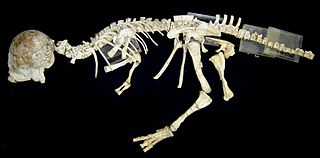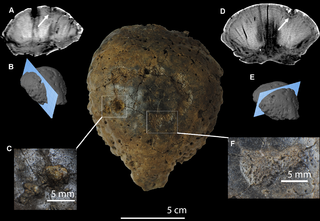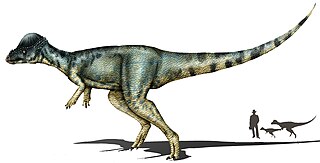
Pachycephalosauria is a clade of ornithischian dinosaurs. Along with Ceratopsia, it makes up the clade Marginocephalia. With the exception of two species, most pachycephalosaurs lived during the Late Cretaceous Period, dating between about 85.8 and 66 million years ago. They are exclusive to the Northern Hemisphere, all of them being found in North America and Asia. They were all bipedal, herbivorous/omnivorous animals with thick skulls. Skulls can be domed, flat, or wedge-shaped depending on the species, and are all heavily ossified. The domes were often surrounded by nodes and/or spikes. Partial skeletons have been found of several pachycephalosaur species, but to date no complete skeletons have been discovered. Often isolated skull fragments are the only bones that are found.

Pachycephalosaurus is a genus of pachycephalosaurid ornithischian dinosaur. The type species, P. wyomingensis, is the only known species, but some researchers argue that Stygimoloch might be a second species, P. spinifer, or a juvenile specimen of P. wyomingensis. It lived during the Maastrichtian age of the Late Cretaceous period in what is now western North America. Remains have been excavated in Montana, South Dakota, Wyoming, and Alberta. The species is known mainly from a single skull, plus a few extremely thick skull roofs. More complete fossils would come to be found in the following years.

Stegoceras is a genus of pachycephalosaurid (dome-headed) dinosaur that lived in what is now North America during the Late Cretaceous period, about 77.5 to 74 million years ago (mya). The first specimens from Alberta, Canada, were described in 1902, and the type species Stegoceras validum was based on these remains. The generic name means "horn roof", and the specific name means "strong". Several other species have been placed in the genus over the years, but these have since been moved to other genera or deemed junior synonyms. Currently only S. validum and S. novomexicanum, named in 2011 from fossils found in New Mexico, remain. The validity of the latter species has also been debated, and it may not even belong to the genus Stegoceras.

Homalocephale is a genus of pachycephalosaurid dinosaur that lived during the Late Cretaceous period of what is now the Nemegt Formation, Mongolia, about 70 million years ago. The genus was described in 1974 by Halszka Osmólska and Teresa Maryańska, and consists of a single species, H. calathocercos. Though Homalocephale has been regarded as a synonym of Prenocephale, juvenile specimens of the latter indicate that they were distinct. Homalocephale was 1.8 m (5.9 ft) long and possibly a omnivore.

Prenocephale is a genus of small pachycephalosaurid dinosaur from the Late Cretaceous Nemegt Formation of Mongolia. It was similar in many ways to its close relative, Homalocephale.

Tylocephale is a genus of pachycephalosaurid dinosaur, a group of dome-headed, herbivorous ornithischians, that lived during the Late Campanian stage of the Late Cretaceous in what is now Mongolia. It is known from a partial skull and associated mandible that were unearthed in 1971 by a Polish-Mongolian Expedition to the Barun Goyot Formation of the Gobi Desert. The specimen was described in 1974 by Polish paleontologists Teresa Maryańska and Halszka Osmólska as a new genus and species.

Colepiocephale is a genus of pachycephalosaurid dinosaur from Late Cretaceous deposits of Alberta, Canada. It was collected from the Foremost Formation. The type species, C. lambei, was originally described by Sternberg, and later renamed by Sullivan in 2003. C. lambei is a domed pachycephalosaur characterized principally by the lack of a lateral and posteriosquamosal shelf, a steeply down-turned parietal, and the presence of two incipient nodes tucked under the posterior margin of the parietosquamosal border.

Nodocephalosaurus is a monospecific genus of ankylosaurid dinosaur from New Mexico that lived during the Late Cretaceous in what is now the De-na-zin member of the Kirtland Formation. The type and only species, Nodocephalosaurus kirtlandensis, is known only from a partial skull. It was named in 1999 by Robert M. Sullivan. Nodocephalosaurus has an estimated length of 4.5 metres and weight of 1.5 tonnes. It is closely related and shares similar cranial anatomy to Akainacephalus.

Goyocephale is an extinct genus of pachycephalosaurian ornithischian that lived in Mongolia during the Late Cretaceous about 76 million years ago. It was first described in 1982 by Altangerel Perle, Teresa Maryańska and Halszka Osmólska for a disarticulated skeleton with most of a skull, part of the forelimb and hindlimb, some of the pelvic girdle, and some vertebrae. Perle et al. named the remains Goyocephale lattimorei, from the Mongolian гоё (goyo), meaning "decorated", and the Ancient Greek κεφαλή (kephale), for head. The species name honours Owen Lattimore.

Hanssuesia is a genus of pachycephalosaurid dinosaurs from the late Cretaceous period. It lived in what is now Alberta and Montana, and contains the single species Hanssuesia sternbergi.

Gravitholus was a genus of pachycephalosaurid dinosaur from the late Cretaceous period. It was a pachycephalosaur, and like other pachycephalosaurids the skull roof formed a thick dome made of dense bone, which may have been used in head-butting contests over mates or territory. It lived in what is now Alberta, Canada, and was described in 1979 by W. P. Wall and Peter Galton. The type species is Gravitholus albertae.

The Kirtland Formation is a sedimentary geological formation.

Alaskacephale is an extinct genus of pachycephalosaurid, a group of dome-headed, herbivorous ornithischian dinosaurs, that lived during the Campanian stage of the Late Cretaceous period in what is now northern Alaska. The genus is one of the few known Arctic dinosaurs and was found in the Prince Creek Formation, which preserves a menagerie of fossils. The only known specimen, a squamosal bone, was found in 1999 and later described in 2005. However, Alaskacephale was not formally named until the next year.

Texacephale is a pachycephalosaurid dinosaur from the Campanian stage of the Late Cretaceous. Its fossils come from the Aguja Formation of Big Bend National Park, in Texas, and were described in 2010 by Longrich, Sankey and Tanke. The generic name means Texas + "head" in reference to its place of discovery, and the specific name langstoni honors Wann Langston.

Foraminacephale is a genus of pachycephalosaurid dinosaur from Late Cretaceous deposits of Canada.

Acrotholus is an extinct genus of pachycephalosaur dinosaur that lived during the Santonian of the late Cretaceous, in the Milk River Formation of Canada. The type species, A. audeti, was named after Roy Audet allowing access to his ranch leading to the discovery of the species. The discovery of this specimen lead to several new revelations in the fossil records questioning the preservation of small-bodied organisms along with the evolution of early pachycephalosaurs. The iconic cranial dome found on Acrotholus makes it one of the earliest indisputable known members of the pachycephalosaur family.

This timeline of pachycephalosaur research is a chronological listing of events in the history of paleontology focused on the pachycephalosaurs, a group of dome-skulled herbivorous marginocephalian dinosaurs. One of the first major events related to the history of pachycephalosaur research actually regards the discovery of an unrelated dinosaur called Troodon, reported from the western United States by Joseph Leidy in 1856. The type specimen of Troodon was simply an unusual tooth, but the close resemblance between Troodon teeth and pachycephalosaur teeth would cause taxonomic confusion for over a century. This was resolved by Phil Currie in 1987, who realized that Troodon belonged to a group of bird-like carnivores then known as saurornithoidids, but since renamed Troodontidae after Troodon itself. The first scientifically documented true pachycephalosaur remains were discovered in Early Cretaceous rocks from England and named Stenopelix not long after Troodon was named in America. Other notable early finds include the well-known pachycephalosaur Stegoceras validum.
Sinocephale is a genus of pachycephalosaurid dinosaur that lived in Inner Mongolia, China during the Cretaceous period. The only species, Sinocephale bexelli, was originally named as a species of the genus Troodon in 1953, and later transferred to the genus Stegoceras. After decades of being considered dubious, it was re-evaluated in 2021 and recognized as a valid taxon, being given a unique generic name. The original holotype was lost, with modern research conducted using rediscovered plaster casts. Scant material makes for limited knowledge of its life appearance, but it is distinguished by an embayment on the back of the domed skull, which would give it a heart shape as seen from above. It is potentially the oldest known pachycephalosaurid and falls within the subset of the family called Pachycephalosaurinae, related to animals such as Pachycephalosaurus and Prenocephale. The geologic context of the species has been historically unclear but it is currently thought to originate in rocks belonging to the Ulansuhai Formation.




















